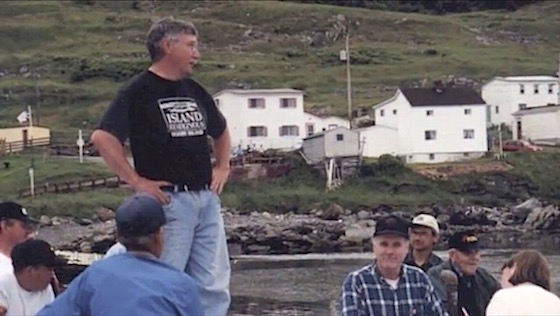04 Jan Building wooden boats in Winterton, Newfoundland
In 2000, my nephew Ingram Barss and I helped Ralph Coates of New Perlican, NL, build a scaled down version of a traditional Newfoundland trap skiff at the community-run Wooden Boat Museum in Winterton, a few kilometres down the Trinity Bay shore from Ralph’s home.
Like tens of thousands of Newfoundlanders before him, Coates went into the woods, found trunks and limbs with just the right shape to form the complex curves of the skiff’s graceful hull, and created a sturdy vessel a fishermen could trust with his life—and his family’s livelihood.
In keeping with local tradition, the boat Coates built had no name. As folklorist David Taylor wrote in his wonderful 1982 study, Boat Building in Winterton, Trinity Bay, Newfoundland:
Boats are regarded as tools, and a Winterton fisherman would no more think of giving his boat a formal name than he would think of naming his chainsaw or his wheelbarrow.*
Today, I was pleased to discover on Facebook a short Newfoundland and Labrador Tourism video about Winterton’s Boat Building Museum. It’s still going strong, even offering boatbuilding courses under the guidance of Jerome Canning of Merasheen Island, Placentia Bay, NL.**
We powered Ralph’s unnamed skiff with a sculling oar and an antique make-n-break engine, made at the Acadia Foundry in Bridgewater NS. Retired school principal and former Winterton Mayor Melvin Green, the moving force behind the museum (and much else that happened in Winterton), graciously facilitated our project. In the summer of 2000, Melvin and I sailed the little boat across Trinity Bay to the abandoned community of Ireland’s Eye, then on to the Random Island home of master boat builder Warren Brooking.***

Launch Day, Winterton: Melvin Green, standing in black tee shirt. Come-From-Away, facing camera in plaid shirt.
* Taylor’s book was reprinted sometime in the early 2000s, but copies are once again hard to find. If you can get your hand on one, in a used bookstore or a library, snap it up. The oral history it contains offer a window into the antique-to-our-ears language and syntax of Newfoundland outports. It will leave you with fresh respect for the people of these traditional communities. (E. Annie Proulx was so charmed by the book, she copied several passages, all but verbatim, into her novel, The Shipping News, with scant credit.)
** Canning was born on Merasheen Island, but grew up in the town of Placentia. Merasheen was resettled in the 1960s as part of Joey Smallwood’s controversial project to close down remote coastal communities. Merasheen is also the birthplace of the great Newfoundland folklorist and singer, Anita Best.
*** Brooking died in 2013 at age 90, but you can see him in a two-part CBC Land and Sea episode about his love of boat building and make-n-breaks (part 1, part 2).
